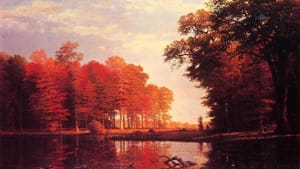Glory be!
The Poetry of Nature at the Brandywine River Museum

Have we lost what they had found? Perhaps. But the landscapes from the mid-19th century Hudson River School can still boost the jaded, cheer the gloomy, and brace up the dour, unless you’re a terminal case.
Organized by the New-York Historical Society from its large collection, the 40 paintings in The Poetry of Nature at the Brandywine Museum make a modest but solid grouping, which boasts at least five superb pictures and a dozen interesting, worthy, beautiful ones.
The unique spirit that makes the Hudson River School so appealing comes, at least in part, from the heritage of Dutch landscape painting of the 17th century, but there is nothing in European art that matches the skies of Frederic Church or Albert Bierstadt. Compare to a Hobbema, Lorrain, Corot — their skies vary, but they are still just skies. Even a dramatic colorist like J.M.W. Turner doesn’t convey the optimism and the confidence these Americans possess — that enticing feeling that’s half being specially favored, the other half especially appreciative.
Several of the paintings on display show the characteristically brightening, golden light that guides the viewer deep into the picture, through the unfolding geography and ever farther on, to some glorious distance in which beauty, religious faith, patriotism, and luminousness all compound into the promise of a future full of progress and improvements.
Lights and highlights
Highlights include a big Bierstadt canvas, Autumn Woods, which measures about 7′x4.5′. The red, red leaves in the foreground pond drift one way, the ducks swim the other way, and the effect feels much more personal than the Yosemite landscapes for which he is better known.

The surprise of the show is its earliest painting, an 1818 view of Niagara Falls that predates the work of the traditionally recognized founder of the Hudson River School, Thomas Cole, who first won notice in 1825. This earlier painting is one of only two identified as the work of the sadly obscure Louisa Davis Minot. It’s a beautifully accomplished canvas with the whites and pinks of the falls’ spray bubbling upwards.
(The coloring of Minot’s falls is also reminiscent, here in the House of Wyeth, of the pinks and whites in Jamie Wyeth’s Recurring Dream series of pictures shown here in 2013, where the Atlantic surf froths on the rocks of Maine’s Monhegan Island in shades more lurid in his but still the same observation as in hers of two centuries ago.)
Beyond the valley
Subjects did not remain merely upstate New York, of course; a panorama like W.L. Sonntag’s Morning in the Blue Ridge Mountains, Virginia projects the peace that can make certain landscapes so appealing. Philadelphia-born William Trost Richards captures a quiet understory scene in June Woods (Germantown) that is almost surely a slope along the Wissahickon Creek, done with a skillful range of light and color gradations in its browns and greens.
Thomas Hotchkiss’s Catskill Mountains, Haying starts to personalize forms in a way that struck me as only two jumps from a van Gogh. Hotchkiss, who died in his 30s, is only one of several painters shown who died young. Most of the Hudson River School were long-lived, but Cole, represented here by a haunted Mountain Landscape, died at 47, George Durrie at 43, and Mary Josephine Walters at 46.
Two problems with the show must be mentioned. Most of the paintings are behind glass and the lighting often reflects off the glass in annoying ways. We do get the big Bierstadt and the Church paintings naked as the day they were born, fortunately. Secondly, a few of the frames are so ornate that they project well out from the canvas surface and cause a little shadow to fall across the top of their paintings, like an awning. (The second floor of the Brandywine is closed for installation of new LED lighting, so that issue may be addressed for the future.)
A nation torn apart
We know that, even though the Civil War tore through the nation at the peak of the Hudson River School’s popularity, history proved the spirit behind these paintings right, and then some. That is also the source of the mixed feelings I could not keep wholly at bay.
If you ever wonder how American society has let itself be held hostage by so many whiners, kvetchers, and painfully eager totalitarians, you too will find in this show a tonic for the soul, a spur to loftier thought, and a little kick in the butt. We may at this moment be fighting a cold Civil War II, but these pictures remind us we were, and could be again, capable of better. Then you get to walk outside onto the banks of the Brandywine, with its canoeists and kayakers, and experience yet another round of refreshment.
What, When, Where
The Poetry of Nature: A Golden Age of American Landscape Painting. Through June 12 at the Brandywine River Museum of Art, 1 Hoffman’s Mill Road, Chadds Ford. 610-388-2700 or brandywine.org
“All Nature Here Is New to Art.” Lecture by Dr. Linda S. Ferber, museum director emerita of the New-York Historical Society Museum, Wednesday, April 13, 6pm.
“Odes to Nature: The Poetry of Landscape Painting.” Gallery talk by Amanda Burdan, Brandywine associate curator, Wednesday, April 27 at 2 pm.
Sign up for our newsletter
All of the week's new articles, all in one place. Sign up for the free weekly BSR newsletters, and don't miss a conversation.
